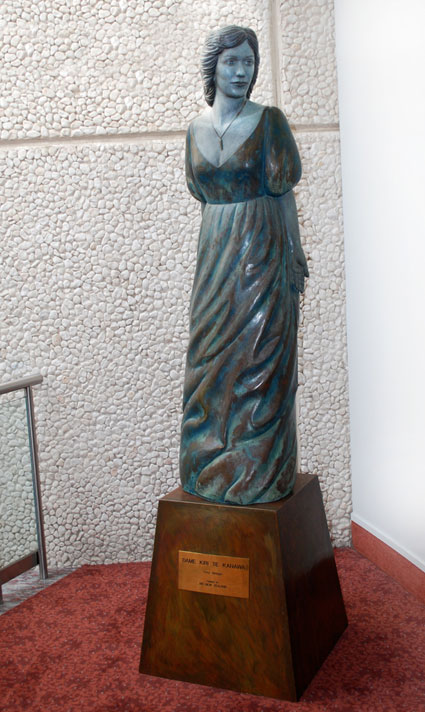
Sculpture of Dame Kiri Te Kanawa
Taken from ‘Aotea Centre Works of Art’, edited by Tara Werner, written by Karen Scherer and Katherine Findlay.
The 1.6 metre painted bronze statue was created by sculptor Terry Stringer. One of a group of artworks commissioned for Aotea – Te Pokapū | Aotea Centre, the bronze was unveiled by Dame Kiri Te Kanawa herself at the official opening of Aotea Centre on 9 September 1990. Located on Level 3 of Aotea Centre, adjacent to Door D into the Kiri Te Kanawa Theatre, the statue presides over visitors entering the theatre itself.
Never intended to be a literal likeness of its subject, Stringer wanted the figure to be seen as a column. The surface modelling is shallow and the arms, gestures and sweep of the drapery are in relief around the work. By making the facial features slightly too large for the head, and the head slightly too large for the body, he meant to emphasise her personality. As an echo of Dame Kiri's encouragement of Aotea Centre, the sculpture also suggests a traditional figurehead. The height of the work means it can easily be seen from a distance, even when the foyer is filled with people. The diva appears to be standing on a platform, and she stoops forward as though taking a bow. There is also the suggestion of a shrug and a slight smile.
Terry Stringer:
My idea of a piece of sculpture has a formal idea, which makes a tension, and gives a sense of my mind at work. A portrait has extra presence with this tension – I don't want it to be too easy.
Stringer first met Dame Kiri in her London home and spent two days making pencil drawings of her, taking photographs of her hair, hands and clothes. The dress she chose for the portrait has the advantage of appearing to be both an opera costume and an evening dress. The pendant she wears was a gift from her late father.
In his Auckland studio, Stringer made a study model of Dame Kiri's head and refined it during a further sitting during her Homecoming tour in early 1990. A full-scale model took three months to construct, and another six weeks to cast. First clay was sculpted on to a supporting metal armature, then a plaster model formed over the clay. From this a wax shell was made which the foundry imbedded in a mould. By burning out the wax and pouring in bronze, a hollow sculpture was achieved. Stringer then cleaned the bronze and perfected the surface, gave it a patina, and delicately coloured it with oil paint.
Artist: Terry Stringer
Date of work: 1990
Medium: Bronze
